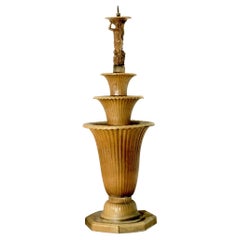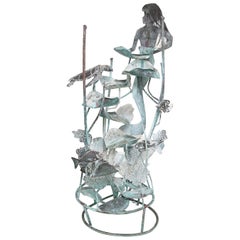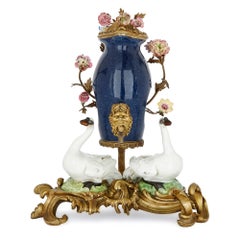Wiener Keramik Werkstätte Fountains
2
to
2
2
2
2
2
2
2
Height
to
2
2
2
2
3
5
4
3
3
Creator: Wiener Keramik Werkstätte
Original and Unique Ceramic Fountain by Otto Prutscher and Michael Powolny, 1914
By Wiener Keramik Werkstätte, Michael Powolny, Otto Prutscher
Located in Vienna, AT
Executed by Michael Powolny for the Wienerberger Keramikwerkstätten, ceramic and stoneware, ochre colored, body holding a dish in her outstretched arms standing above a three-tired C...
Category
Early 20th Century Austrian Jugendstil Wiener Keramik Werkstätte Fountains
Materials
Ceramic, Stoneware
Original and Unique Ceramic Fountain by Otto Prutscher and Michael Powolny, 1914
By Michael Powolny, Wiener Keramik Werkstätte, Otto Prutscher
Located in Vienna, AT
Executed by Michael Powolny for the Wienerberger Keramikwerkstätten, ceramic and stoneware, ochre colored, body holding a dish in her outstretched arms standing above a three-tired Cascade of basins with fluted decoration.
One image shows the model of the fountain in the studio of the "Gebrueder Schwadron" in Vienna, circa 1910-1914.
Literature: Karl Maria Grimme, Gärten von Albert Esch, Wien, Leipzig 1931 p.29.
Elisabeth Frottier, Michael Powolny, Keramik und Glas aus Wien 1900...
Category
Early 20th Century Austrian Jugendstil Wiener Keramik Werkstätte Fountains
Materials
Ceramic, Stoneware
Related Items
Copper Mermaid Fountain by Glen Mayo
By Glen Mayo
Located in West Palm Beach, FL
Whimsical fountain sculpture, of copper, by metal artist Glen Mayo; its mermaid focal point holding a leaf which cascades water down the fountain, among turtles, angel fish, other se...
Category
1990s North American Wiener Keramik Werkstätte Fountains
Materials
Copper
Meissen style porcelain and gilt bronze table fountain by Samson
Located in London, GB
This colourful porcelain table fountain, fashioned in the German Meissen style, was crafted in the 19th Century by the French porcelain company Samson et Cie.
The table fountain co...
Category
19th Century German Louis XV Antique Wiener Keramik Werkstätte Fountains
Materials
Ormolu
Ukiyo Saucer, Concrete Fountain/Fishpond by OPIARY (D50")
By Robert Remer
Located in Brooklyn, NY
Opiary is a Brooklyn-based biophilic design and production studio. We integrate nature in each of our designs, incorporating live greenery and organic shapes into bespoke furniture, planters, and sculpture. Through the ethos of biophilia, our work reflects the shifting, yet timeless relationship between humans and nature.
This modern, minimalist fountain is a tasteful way to incorporate aquatic life into any indoor or outdoor space. The Ukiyo Saucer...
Category
21st Century and Contemporary Modern Wiener Keramik Werkstätte Fountains
Materials
Cement
Wonderful Modernist Kenetic Motion Copper Fountain / Water Feature, Hand Made
Located in Buffalo, NY
Ingenious copper fountain / water feature, solid copper construction, Modernist design Artisan made, hand executed. Sculpture in motion, great for garden, or indoor space.
Category
1970s American Mid-Century Modern Vintage Wiener Keramik Werkstätte Fountains
Materials
Copper
Nude Male Bronze Sculpture Fountain
Located in Malibu, CA
Bronze male sculpture signed. Fonderia Giorgio Sommer Calabritto Napoli
Thomas, sculptor, lived and worked in the Naples area, and especially on Capri, from 1889 to 1906. Given this ...
Category
20th Century Italian Renaissance Wiener Keramik Werkstätte Fountains
Materials
Carrara Marble, Bronze
Ukiyo Saucer, Concrete Fountain/Fishpond by OPIARY (D62")
By Robert Remer
Located in Brooklyn, NY
Opiary is a Brooklyn-based biophilic design and production studio. We integrate nature in each of our designs, incorporating live greenery and organic shapes into bespoke furniture, planters, and sculpture. Through the ethos of biophilia, our work reflects the shifting, yet timeless relationship between humans and nature.
This modern, minimalist fountain is a tasteful way to incorporate aquatic life into any indoor or outdoor space. The Ukiyo watersaucer can house multiple floating islands...
Category
21st Century and Contemporary Modern Wiener Keramik Werkstätte Fountains
Materials
Cement
American Giant Stone Frog with Patina, Originally Used as a Fountain
Located in Atlanta, GA
An American giant stone frog from the 20th century, with great patina. Made in the USA in 1987, this giant stone stone frog used to be a fountain (notice the remnants of a pipe below...
Category
1980s American Vintage Wiener Keramik Werkstätte Fountains
Materials
Stone
19th Century French Marble and Bronze Fountain
Located in Essex, MA
19th century French marble and bronze fountain. Seated satyr on marble column with marble shell basin. Later cast stone plinth. Wonderful garden ele...
Category
Late 19th Century French Louis XV Antique Wiener Keramik Werkstätte Fountains
Materials
Marble, Bronze
Art Nouveau Bronze Sculptural Tray Indoor Fountain with Nude by Suzanne Bizard
By Susanne Bizard
Located in Antwerp, BE
Art Nouveau bronze sculptural tray indoor fountain with seated nude holding a vase signed by Suzanne Bizard.
Patinated bronze on impressive marble tr...
Category
Early 1900s French Art Nouveau Antique Wiener Keramik Werkstätte Fountains
Materials
Marble, Bronze
H 14.77 in W 18.12 in D 12.21 in
Michael Powolny Style Putto or Putti Ceramic Sculpture
By Michael Powolny
Located in New York, NY
Exceptional Austrian Putto in the style of Michael Powolny with bow, arrow and quiver on his back sitting on a colorful bed of blue bubbles. Magnificent s...
Category
1920s Austrian Vintage Wiener Keramik Werkstätte Fountains
Materials
Ceramic, Stoneware
Architectural Ceramic Water Fountains Sculptures Bronze Glazed 1960 Mobach
By Mobach
Located in London, GB
The sculptural head shaped water features hand-turned in ceramic, produced by Mobach in Utrecht during the 1960's. Mobach produced this unique mat bronze lustre glaze has a result of...
Category
1960s European Mid-Century Modern Vintage Wiener Keramik Werkstätte Fountains
Materials
Ceramic
H 27.56 in W 11.82 in D 7.88 in
Italian Ancient Marble Sculpture Fountain, Late 16th Century
Located in Milano, IT
Sea monster
Carrara marble mouth fountain
Italy, late 16th century
It measures 13.8 x 31.5 x 18.9 in (35 x 80 x 48 cm)
State of conservation: some small evident gaps and widespread signs of wear due to outdoor exposure. The gray marks crossing it do not come from restoration, but are rather the natural veins of the marble.
This work has some morphological characteristics typically associated with the iconography of the sea monster: an elongated muzzle, sharp teeth, protruding eyes, elongated ears, and a coiled serpent's tail.
An in-depth series of studies on artistic depictions of the sea monster attempted to verify how this symbol evolved in antiquity in the European and Mediterranean contexts and how it gradually changed its image and function over time. The iconography itself is mutable and imaginative and its history is rich with cultural and artistic exchange, as well as the overlapping of ideas. This occurred so much that it is difficult to accurately pinpoint the "types" that satisfactorily represent its various developments.
However, we can try to summarize the main figures, starting from the biblical Leviathan and the marine creature that swallowed Jonah (in the Christian version, this figure was to become a whale or a "big fish", the “ketos mega”, translation of the Hebrew “dag gadol”). Other specimens ranged from the dragons mentioned in the Iliad (which were winged and had legs) to "ketos” (also from Greek mythology), the terrifying being from whose Latinized name (“cetus”) derives the word "cetacean". See J. Boardman, “Very Like a Whale” - Classical Sea Monsters, in Monsters and Demons in the Ancient and Medieval Worlds, in Papers presented in Honor of Edith Porada, Mainz am Rhein 1987, pp. 73-84).
In Italy the monster underwent yet further variations: it can be found in Etruscan art on the front of some sarcophagi representing the companion of souls, while among the Romans we find the “Pistrice” (cited by Plinio in Naturalis Historia PLIN., Nat., II 9, 8 and by Virgilio in Eneide: VERG., Aen., III, 427), which appeared in the shape of a stylized hippocampus or a very large monstrous cetacean and evolved into a hideous being with a dragon's head and long webbed fins.
During the Middle Ages, the sea monster was the object of new transformations: at this time, it is often winged, the head is stretched like a crocodile, the front legs are often very sharp fins - sometimes real paws - until the image merges with dragons, the typical figures of medieval visionary spirituality widely found throughout Europe (on this topic and much more, see: Baltrušaitis, J., Il Medioevo fantastico. Antichità ed esotismi nell’arte gotica, Gli Adelphi 1997).
In Italy during the 15th and 16th centuries, the revival of classicism - representative of the humanistic and Renaissance periods - led to a different reading of these "creatures". Indeed, the sea monster was also to find widespread use as an isolated decorative motif, especially in numerous fountains and sculptures where dolphins or sea monsters were used as a characterizing element linked to water (on this theme see: Chet Van Duzer, Sea Monsters on Medieval and Renaissance Maps, London, The British library, 2013).
From the morphological point of view, the "sea monsters" of this period are mostly depicted as hybrid figures, in which the body of a mythological or real being (a hippocampus, a sea snake, a dolphin), is joined to a head with a rather indistinct appearance. It was usually characterized by large upright ears, an elongated snout, sharp teeth and globular, protruding eyes; a complex and indefinite figure, both from the symbolic point of view and from that of its genesis.
The work we are examining is placed as a cross between the medieval sea serpent and the Renaissance dolphin, with stylistic features which recall the snake as often used in heraldry (such as the "snake" depicted in the coat of arms of the Visconti - the lords and then dukes of Milan between 1277 and 1447 - and which, for some, may be derived from the representations of the “Pistrice” that swallowed Jonah).
In the search for sources, Renaissance cartography and in particular woodcuts should not be neglected. See for example the monsters of Olaus Magnus, from the editions of the “Historia de gentibus septentrionalibus” (“History of the peoples of the north”) and the natural histories of Conrad Gesner, Ulisse...
Category
16th Century Italian Renaissance Antique Wiener Keramik Werkstätte Fountains
Materials
Carrara Marble
Wiener Keramik Werkstätte fountains for sale on 1stDibs.
Wiener Keramik Werkstätte fountains are available for sale on 1stDibs. These distinctive items are frequently made of stoneware and are designed with extraordinary care. There are many options to choose from in our collection of Wiener Keramik Werkstätte fountains, although brown editions of this piece are particularly popular. Many of the original fountains by Wiener Keramik Werkstätte were created in the Art Nouveau style in europe during the early 20th century. Prices for Wiener Keramik Werkstätte fountains can differ depending upon size, time period and other attributes — on 1stDibs, these items begin at $160,819 and can go as high as $160,819, while a piece like these, on average, fetch $160,819.



